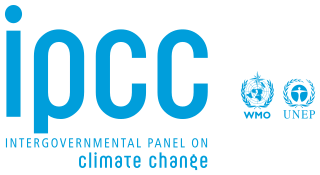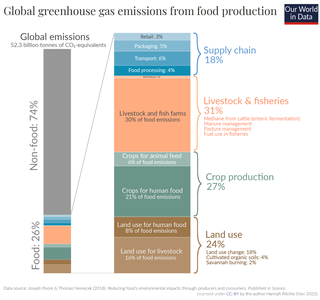
Arable land is any land capable of being ploughed and used to grow crops. Alternatively, for the purposes of agricultural statistics, the term often has a more precise definition:
Arable land is the land under temporary agricultural crops, temporary meadows for mowing or pasture, land under market and kitchen gardens and land temporarily fallow. The abandoned land resulting from shifting cultivation is not included in this category. Data for 'Arable land' are not meant to indicate the amount of land that is potentially cultivable.

Environmental vegetarianism is the practice of vegetarianism that is motivated by the desire to create a sustainable diet, which avoids the negative environmental impact of meat production. Livestock as a whole is estimated to be responsible for around 15% of global greenhouse gas emissions. As a result, significant reduction in meat consumption has been advocated by, among others, the Intergovernmental Panel on Climate Change in their 2019 special report and as part of the 2017 World Scientists' Warning to Humanity.

Land use, land-use change, and forestry (LULUCF), also referred to as Forestry and other land use (FOLU) or Agriculture, Forestry and Other Land Use (AFOLU), is defined as a "greenhouse gas inventory sector that covers emissions and removals of greenhouse gases resulting from direct human-induced land use such as settlements and commercial uses, land-use change, and forestry activities."
Greenhouse gas inventories are emission inventories of greenhouse gas emissions that are developed for a variety of reasons. Scientists use inventories of natural and anthropogenic (human-caused) emissions as tools when developing atmospheric models. Policy makers use inventories to develop strategies and policies for emissions reductions and to track the progress of those policies.

In the context of energy production, biomass is matter from recently living organisms which is used for bioenergy production. Examples include wood, wood residues, energy crops, agricultural residues including straw, and organic waste from industry and households. Wood and wood residues is the largest biomass energy source today. Wood can be used as a fuel directly or processed into pellet fuel or other forms of fuels. Other plants can also be used as fuel, for instance maize, switchgrass, miscanthus and bamboo. The main waste feedstocks are wood waste, agricultural waste, municipal solid waste, and manufacturing waste. Upgrading raw biomass to higher grade fuels can be achieved by different methods, broadly classified as thermal, chemical, or biochemical.

Greenhouse gas (GHG) emissions from human activities intensify the greenhouse effect. This contributes to climate change. Carbon dioxide, from burning fossil fuels such as coal, oil, and natural gas, is one of the most important factors in causing climate change. The largest emitters are China followed by the United States. The United States has higher emissions per capita. The main producers fueling the emissions globally are large oil and gas companies. Emissions from human activities have increased atmospheric carbon dioxide by about 50% over pre-industrial levels. The growing levels of emissions have varied, but have been consistent among all greenhouse gases. Emissions in the 2010s averaged 56 billion tons a year, higher than any decade before. Total cumulative emissions from 1870 to 2022 were 703 GtC, of which 484±20 GtC from fossil fuels and industry, and 219±60 GtC from land use change. Land-use change, such as deforestation, caused about 31% of cumulative emissions over 1870–2022, coal 32%, oil 24%, and gas 10%.

A forest product is any material derived from forestry for direct consumption or commercial use, such as lumber, paper, or fodder for livestock. Wood, by far the dominant product of forests, is used for many purposes, such as wood fuel or the finished structural materials used for the construction of buildings, or as a raw material, in the form of wood pulp, that is used in the production of paper. All other non-wood products derived from forest resources, comprising a broad variety of other forest products, are collectively described as non-timber forest products (NTFP). Non-timber forest products are viewed to have fewer negative effects on forest ecosystem when providing income sources for local community.

Livestock's Long Shadow: Environmental Issues and Options is a United Nations report, released by the Food and Agriculture Organization (FAO) of the United Nations on 29 November 2006, that "aims to assess the full impact of the livestock sector on environmental problems, along with potential technical and policy approaches to mitigation". It stated that livestock accounts for 18% of anthropogenic greenhouse gas emissions, a figure which FAO changed to 14.5% in its 2013 study Tackling climate change through livestock.

A low-carbon diet is any diet that results in lower greenhouse gas emissions. Choosing a low carbon diet is one facet of developing sustainable diets which increase the long-term sustainability of humanity. Major tenets of a low-carbon diet include eating a plant-based diet, and in particular little or no beef and dairy. Low-carbon diets differ around the world in taste, style, and the frequency they are eaten. Asian countries like India and China feature vegetarian and vegan meals as staples in their diets. In contrast, Europe and North America rely on animal products for their Western diets.
The term food system describes the interconnected systems and processes that influence nutrition, food, health, community development, and agriculture. A food system includes all processes and infrastructure involved in feeding a population: growing, harvesting, processing, packaging, transporting, marketing, consumption, distribution, and disposal of food and food-related items. It also includes the inputs needed and outputs generated at each of these steps.
The FAO Country Profiles is a multilingual web portal that repackages the Food and Agriculture Organization of the United Nations (FAO) information archive on its global activities in agriculture and food security in a single area and catalogues it exclusively by country and thematic areas.

The Global Forest Resources Assessment (FRA) reports on the status and trends of the world's forest resources. It is led by the Food and Agriculture Organization of the United Nations (FAO).

The United Nations' Intergovernmental Panel on Climate Change's (IPCC) Special Report on Climate Change and Land (SRCCL), also known as the "Special Report on climate change, desertification, land degradation, sustainable land management, food security, and greenhouse gas fluxes in terrestrial ecosystems", is a landmark study from 2019 by 107 experts from 52 countries. The SRCCL provides a comprehensive overview of the entire land-climate system for the first time and decided to enlist land as a "critical resource". The IPCC's 50th session (IPCC-50) formally adopted the SRCCL's Summary for policymakers (SPM) and approved the underlying report. The SPM and the full text of Special Report on Climate Change and Land—in an unedited form—were released on 8 August 2019. The report is over 1,300 pages long and includes the work of 107 experts from 52 countries.

The amount of greenhouse gas emissions from agriculture is significant: The agriculture, forestry and land use sectors contribute between 13% and 21% of global greenhouse gas emissions. Emissions come from direct greenhouse gas emissions. And from indirect emissions. With regards to direct emissions, nitrous oxide and methane makeup over half of total greenhouse gas emissions from agriculture. Indirect emissions on the other hand come from the conversion of non-agricultural land such as forests into agricultural land. Furthermore, there is also fossil fuel consumption for transport and fertilizer production. For example, the manufacture and use of nitrogen fertilizer contributes around 5% of all global greenhouse gas emissions. Livestock farming is a major source of greenhouse gas emissions. At the same time, livestock farming is affected by climate change.
The World Programme for the Census of Agriculture (WCA) is an international programme led by the Food and Agriculture Organization of the United Nations (FAO) that supports the implementation of national censuses of agriculture on a 10-year basis through the use of standard concepts, definitions and methodology. The WCA was developed in the years 1929–1930 by the International Institute of Agriculture (IIA). Governments from many countries agreed to promote a coordinated implementation of censuses of agriculture around the world on a basis as uniform as possible. The WCA 1929–1930 constituted the first world census of agriculture round and was implemented in about 60 countries. The subsequent 1940 round could not be completed due to the onset of World War II. Following the dissolution of the IIA in 1946, the Food and Agriculture Organization of the United Nations (FAO) took over the programme and launched in 1948 the WCA 1950 as well as the successive decennial programmes. Seven decennial rounds – in 1950, 1960, 1970, 1980, 1990, 2000, 2010 and 2020 – have been promoted by FAO. The current WCA 2020 is the tenth decennial international census of agriculture round and covers the censuses of agriculture to be carried out by countries between 2016 and 2025.










